Single-cell RNA Seq reveals cellular landscape-specific characteristics and potential etiologies for adolescent idiopathic scoliosis
- PMID: 35005449
- PMCID: PMC8717101
- DOI: 10.1002/jsp2.1184
Single-cell RNA Seq reveals cellular landscape-specific characteristics and potential etiologies for adolescent idiopathic scoliosis
Abstract
Backgrounds: Abnormal vertebral growth and development have been found in adolescent idiopathic scoliosis (AIS) patients, and the proliferation and differentiation of bone development-related cells play important roles in its pathogenesis. However, a comprehensive single-cell-level differentiation roadmap in AIS has not been achieved.
Methods: The present study compared the single-cell level cellular landscapes of spinal cancellous bone tissues between AIS patients and healthy subjects using high throughput single-cell RNA sequencing (scRNA-seq), which covers multiple cellular lineages including osteoblast, chondrocyte, osteoclast and related immunocytes. We constructed the differentiation trajectories of bone development-related cell lineages through pseudotime analysis, and the intercellular-communication networks between bone development-related cells and immunocytes were further developed.
Results: A total of 11 distinct cell clusters were identified according to the genome-wide transcriptome profiles. t-Distributed stochastic neighbor embedding (t-SNE) analysis showed that mesenchymal stem cells (MSC) were classified into three subtypes: MSC-LOXL2, MSC-IGFBP5, and MSC-GJA1. Gene ontology (GO) analysis showed that MSC-GJA1 might possess greater osteoblast differentiation potential than the others. MSC-IGFBP5 was the specific MSC subtype observed only in AIS. There were two distinct gene expression clusters: OB-DPT and OB-OLFML2B, and the counts of osteoblasts derived from AIS was significantly less than that of non-AIS subjects. In AIS patients, MSC-IGFBP5 failed to differentiate into osteoblasts and exhibited negative regulation of cell proliferation and enhanced cell death. CPC-PCNA was found to be the specific chondrocyte progenitor cell (CPC) subtype observed only in AIS patients. The cell counts of OC-BIRC3 in AIS were less than those in controls. Pseudotime analysis suggested two possible distinct osteoclast differentiation patterns in AIS and control subjects. Monocytes in AIS mainly differentiated into OC-CRISP3.
Conclusions: Our single-cell analysis first revealed differences existed in the cellular states between AIS patients and healthy subjects and found the differentiation disruption of specific MSC and CPC clusters in AIS. Cell communication analysis provided the possible pathogenesis of osteoblast and chondrocyte differentiation dysfunction in AIS.
Keywords: adolescent idiopathic scoliosis; differentiation; etiology; single‐cell RNA sequencing.
© 2021 The Authors. JOR Spine published by Wiley Periodicals LLC on behalf of Orthopaedic Research Society.
Figures
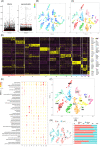
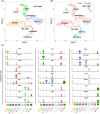

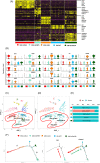
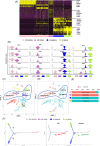
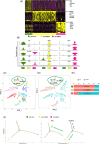
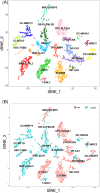
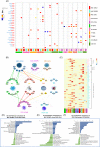
Similar articles
-
Differential miRNAs profile and bioinformatics analyses in bone marrow mesenchymal stem cells from adolescent idiopathic scoliosis patients.Spine J. 2019 Sep;19(9):1584-1596. doi: 10.1016/j.spinee.2019.05.003. Epub 2019 May 14. Spine J. 2019. PMID: 31100472
-
Identification of Differential Genes Expression Profiles and Pathways of Bone Marrow Mesenchymal Stem Cells of Adolescent Idiopathic Scoliosis Patients by Microarray and Integrated Gene Network Analysis.Spine (Phila Pa 1976). 2016 May;41(10):840-55. doi: 10.1097/BRS.0000000000001394. Spine (Phila Pa 1976). 2016. PMID: 26679893
-
Single-cell RNA sequencing deconvolutes the in vivo heterogeneity of human bone marrow-derived mesenchymal stem cells.Int J Biol Sci. 2021 Oct 11;17(15):4192-4206. doi: 10.7150/ijbs.61950. eCollection 2021. Int J Biol Sci. 2021. PMID: 34803492 Free PMC article.
-
Etiopathogenesis of adolescent idiopathic scoliosis: Review of the literature and new epigenetic hypothesis on altered neural crest cells migration in early embryogenesis as the key event.Med Hypotheses. 2021 Jun;151:110585. doi: 10.1016/j.mehy.2021.110585. Epub 2021 Mar 29. Med Hypotheses. 2021. PMID: 33932710 Review.
-
Research progress on the regulation of bone marrow stem cells by noncoding RNAs in adolescent idiopathic scoliosis.J Cell Physiol. 2023 Oct;238(10):2228-2242. doi: 10.1002/jcp.31119. Epub 2023 Sep 8. J Cell Physiol. 2023. PMID: 37682901 Review.
Cited by
-
Investigating the Differential Circulating microRNA Expression in Adolescent Females with Severe Idiopathic Scoliosis: A Proof-of-Concept Observational Clinical Study.Int J Mol Sci. 2024 Jan 1;25(1):570. doi: 10.3390/ijms25010570. Int J Mol Sci. 2024. PMID: 38203740 Free PMC article.
-
Integrated single-cell analyses decode the developmental landscape of the human fetal spine.iScience. 2022 Jun 27;25(7):104679. doi: 10.1016/j.isci.2022.104679. eCollection 2022 Jul 15. iScience. 2022. PMID: 35832888 Free PMC article.
-
Advances in basic and preclinical spine research: Highlights from the Chinese Spine Research Community.JOR Spine. 2021 Dec 21;4(4):e1188. doi: 10.1002/jsp2.1188. eCollection 2021 Dec. JOR Spine. 2021. PMID: 35005451 Free PMC article. No abstract available.
-
Getting to the Core: Exploring the Embryonic Development from Notochord to Nucleus Pulposus.J Dev Biol. 2024 Jul 3;12(3):18. doi: 10.3390/jdb12030018. J Dev Biol. 2024. PMID: 39051200 Free PMC article. Review.
-
Application of Single-Cell and Spatial Omics in Musculoskeletal Disorder Research.Int J Mol Sci. 2023 Jan 23;24(3):2271. doi: 10.3390/ijms24032271. Int J Mol Sci. 2023. PMID: 36768592 Free PMC article. Review.
References
-
- Grossman DC, Curry SJ, Owens DK, et al. Screening for adolescent idiopathic scoliosis: US preventive services task force recommendation statement. JAMA. 2018;319(2):165‐172. - PubMed
-
- Kouwenhoven JW, Castelein RM. The pathogenesis of adolescent idiopathic scoliosis: review of the literature. Spine. 2008;33(26):2898‐2908. - PubMed
LinkOut - more resources
Full Text Sources
Miscellaneous

